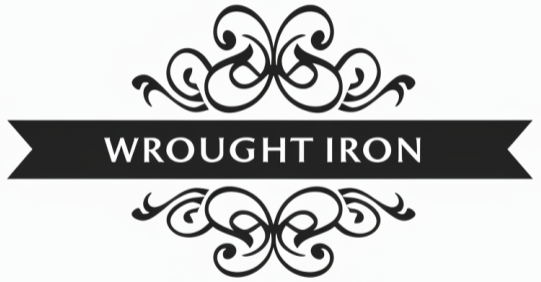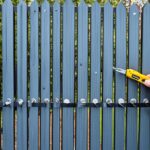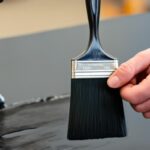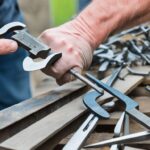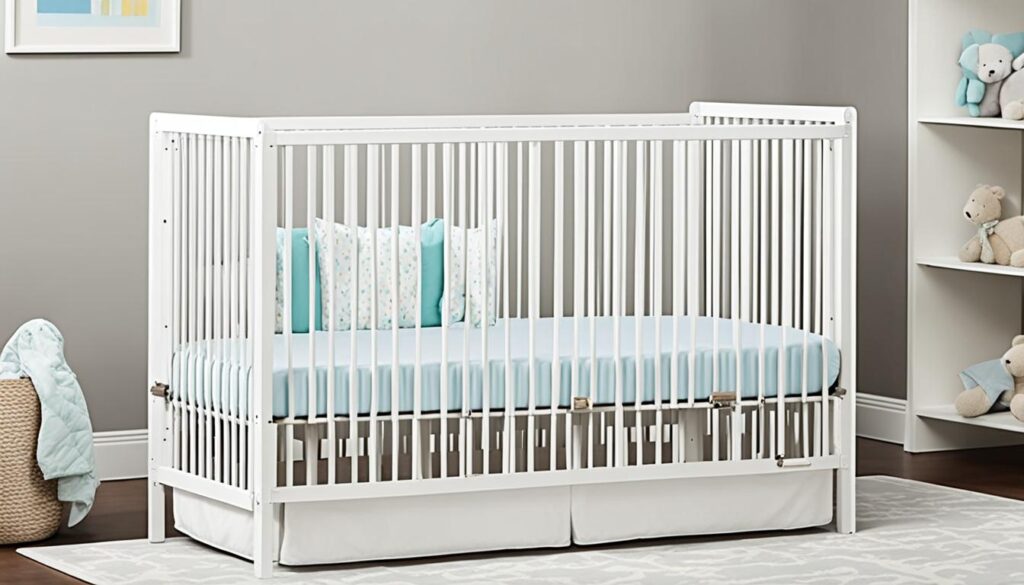
Choosing the right crib for your baby is a big decision. You want it to be safe, functional, and stylish. Wrought iron cribs look modern and sleek, but you might wonder if they’re safe. It’s important to know if they meet safety standards and how they stack up against wooden cribs.
In the U.S., new cribs must follow strict safety rules set by the Consumer Product Safety Commission (CPSC)1. These rules make sure cribs are safe for your child. Many cribs also get a thumbs up from the Juvenile Products Manufacturers Association, giving parents more confidence1. But, there are still questions about the safety and usefulness of wrought iron cribs, especially when it comes to old crib rules.
Creating a safe sleep area for your baby is key. Putting your baby on their back in a crib without blankets, pillows, or other dangers cuts down SIDS risk2. Whether you pick a wrought iron, wooden, or another crib, make sure it follows the latest safety rules.
Key Takeaways
- Understand the balance of style, functionality, and safety when selecting a crib.
- Wrought iron cribs must meet stringent baby crib safety standards set by organizations like the CPSC and ASTM.
- Ensuring a safe sleep environment involves eliminating potential hazards like blankets, pillows, and cords from the crib.
- The Juvenile Products Manufacturers Association certifies many cribs to provide additional safety assurance1.
- Always verify crib certifications and inspect for sharp edges or hazardous chemicals before purchasing.
Understanding Wrought Iron Cribs
Wrought iron cribs are back in style, loved for their lasting quality and good looks. They fit well in any nursery, offering both style and safety. Their lasting design and beauty have made them popular over the years.
Features of Wrought Iron Cribs
Some parents worry about iron cribs being less safe than wooden ones, fearing kids might get hurt or chew on the rails3. But iron cribs are known for being very strong and lasting a long time4. They can be a bit heavy, but many find them just as easy to move as wooden ones3.
Iron cribs are known for lasting a long time, often becoming family treasures3. They don’t easily get scratched or dented, keeping their looks for years5. They might be pricier than wooden cribs4, but their durability makes them a good value. It’s key to pick one that meets safety standards from trusted groups like the CPSC and JPMA5.
Historical Context and Modern Use
Iron cribs have a long history, known for their beauty and strength. They were highly valued in the past and still are today for the same reasons4. Today’s iron cribs follow safety rules but keep their classic look and build3.
Now, iron cribs are loved for their modern look, fitting many nursery themes5. Parents pick them for mixing old charm with new style5. Plus, they’re easy to clean with wipes, keeping the crib safe and clean for the baby5.
In summary, wrought iron cribs mix old-time beauty with today’s needs, making them a great choice for parents looking for cribs that last.
Are Wrought Iron Cribs Safe?: Safety Concerns and Considerations
When looking at wrought iron cribs for your baby, it’s key to know the safety issues and steps to take. You need to check for risks like lead-based paint and make sure the crib doesn’t tip over. These are key to making sure these cribs are safe for your baby.
Lead-Based Paint Risks
Lead-based paint is a big health risk, especially for babies and young kids. Even though we can’t use lead in cribs anymore, old or used wrought iron cribs might still have it. This paint is dangerous if your baby eats it6. To keep your baby safe, make sure any used crib you buy or get from family meets today’s safety rules. It should have safe finishes6. Keeping your baby away from lead-based paint is crucial to avoid serious health problems.
Addressing Sharp Edges and Stability
Wrought iron cribs can have sharp edges that might hurt your baby. But, new designs often have smooth edges to lower this risk7. It’s also important that the crib doesn’t tip over. Cribs that are well-made and strong are safer for your baby7. Always check the crib for any paint that’s peeling or other safety problems7.
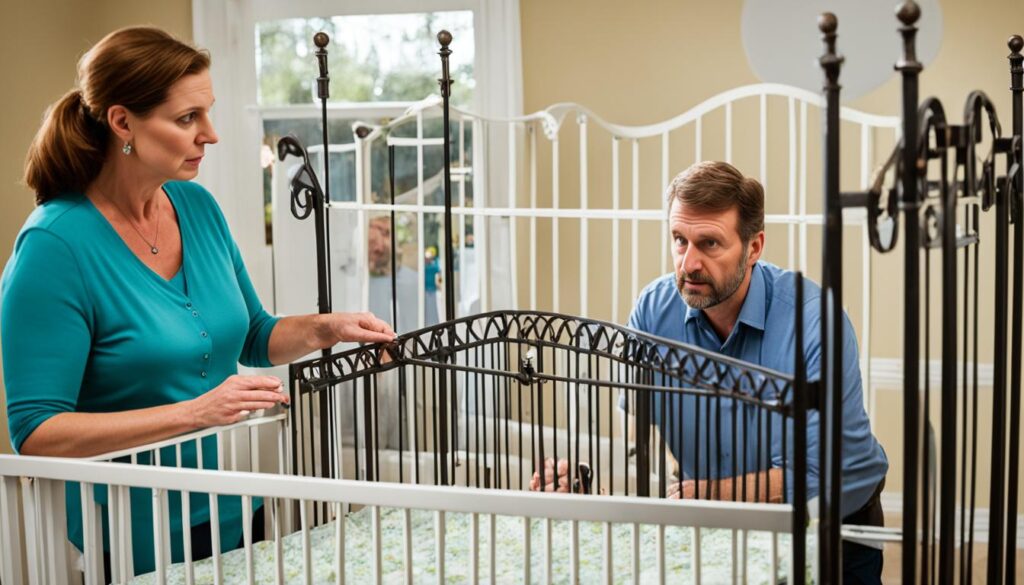
Here’s a table that shows how wrought iron cribs and wood cribs compare in safety and other areas. It helps you pick the safest place for your baby to sleep:
| Feature | Wrought Iron Cribs | Wood Cribs |
|---|---|---|
| Lead-Based Paint | Modern cribs: Lead-free; Vintage cribs: Potential risk | Generally lead-free, especially in newer models |
| Crib Stability | Requires sturdy welds and strong construction7 | Heavier and naturally stable6 |
| Customizability | Fewer design options6 | Greater variety in colors, finishes, and styles7 |
| Noise Level | Prone to noise due to metal structure6 | Quieter due to wood’s natural properties6 |
| Non-Toxic Finishes | Common in modern cribs | Widespread, especially in sustainably sourced models6 |
Compliance with Baby Crib Safety Standards
Keeping wrought iron cribs safe means following strict safety standards. These include the ASTM safety standards and CPSC compliance. Knowing these rules helps make sure your crib is safe and keeps your baby safe from harm.
Overview of ASTM and CPSC Safety Standards
The CPSC set new crib safety rules in 2012, focusing on places like hospitals and daycare centers8. Cribs in the U.S. must follow Standards 16 CFR 1219 and 16 CFR 1220, which started in 20118. These rules require cribs to have strong hardware, wide slats, and sturdy mattress supports for better safety8.
Also, by December 31, 2012, all childcare places had to replace old cribs that didn’t meet the new rules8. This was to get rid of cribs with drop-side rails, which were dangerous, and switch to safer ones9. In 2010, the CPSC, ASTM, and JPMA worked together to fix safety issues and make cribs safer9.
Ensuring Non-Toxic Finishes
It’s also key to make sure the finishes on cribs are safe and non-toxic. The CPSC has rules to stop cribs from having harmful substances like lead9. When picking a wrought iron crib, check that the finishes are safe, so your baby stays safe from harmful materials.
New safety rules from June 28, 2011, aim to stop accidents and keep kids safe in their cribs10. With over 11 million cribs recalled since 200710, making sure cribs have non-toxic finishes is crucial for safety.
| Safety Standard | Requirement |
|---|---|
| ASTM Safety Standards | Heavy-duty hardware, thicker slats, strong mattress supports8 |
| CPSC Compliance | No drop-side rails, non-toxic finishes9 |
| Manufacturing Date | Cribs made after July 28, 20118 |
Inspection and Maintenance of Wrought Iron Cribs
Keeping your baby’s sleep area safe means checking and assembling wrought iron cribs often. Making sure these items are in good shape cuts down on accident risks and helps them last longer.
Regular Crib Inspection Checklist
Checking your baby furniture regularly is key. Look for any wear or damage during your checks. Make sure all screws, bolts, and hardware are tight and complete. The slats should be no more than 2 3/8 inches apart to keep your baby safe11. This means a soda pop can can’t fit through12. Check that the mattress support hangers are securely attached to avoid risks12.
Proper Assembly Instructions
Assembling your wrought iron crib right is crucial for its safety and stability. Cribs must have fixed sides because drop-side cribs are dangerous and banned in the US1312. The mattress should fit well, leaving no more than two finger widths of space around it1312. Also, make sure all parts fit together well to reduce hazards.
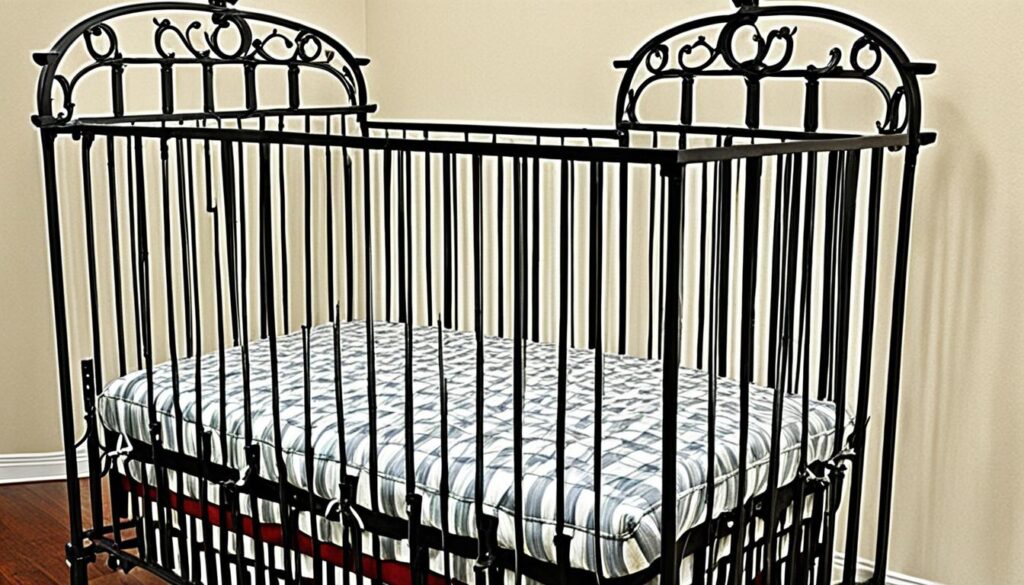
Comparing Wrought Iron Cribs to Wood and Other Metal Cribs
Wrought iron cribs are known for their strength and long life, making them a great choice for families. They often last longer than wooden cribs14. Wooden cribs, though, are more stable and less likely to move when rocked, which is good for a peaceful sleep14. Plus, wooden cribs can be turned into toddler or sofa beds, which wrought iron ones usually can’t14.
Durability and Longevity
Wrought iron cribs are very durable and can last for many years without showing much wear. Wooden cribs might get more marks from baby’s teeth14. But, they move less and are more stable, which can make for a quieter sleep14.
Design and Aesthetic Appeal
Wrought iron cribs have a unique and classy look that fits many nursery styles. Wooden cribs also come in many designs and colors, fitting most themes15. Wooden cribs are easier to match with other nursery furniture, creating a unified look14.
Sleep Environment and Noise Levels
The sleep environment is key. Metal cribs, like wrought iron ones, can be noisier because of the metal’s sound when the baby moves1415. Wooden cribs are quieter because they’re solid15. Wrought iron cribs might feel cooler, which could be bad for babies in the cold14. Parents should keep the nursery warm and use breathable bedding to keep their babies comfy1516.
FAQ
Are wrought iron cribs safe for babies?
What are the main safety concerns with wrought iron cribs?
How should I inspect a wrought iron crib for safety?
How do wrought iron cribs comply with ASTM and CPSC safety standards?
What are the risks associated with lead-based paint on cribs?
What features do wrought iron cribs offer?
What are the benefits of non-toxic finishes on baby cribs?
How do wrought iron cribs compare to wood cribs in terms of noise levels?
What should be included in a regular crib inspection checklist?
What are some key factors to consider when assembling a wrought iron crib?
How do wrought iron cribs compare to wood cribs in terms of durability?
What aesthetic appeal do wrought iron cribs offer compared to other crib materials?
Source Links
- Best Crib Buying Guide – Consumer Reports – https://www.consumerreports.org/babies-kids/cribs/buying-guide/
- Is Your Crib as Safe as You Think? – https://www.preciouslittlesleep.com/safe-crib/
- Wrought iron cribs vs Wooden cribs – https://www.dcurbanmom.com/jforum/posts/list/62403.page
- Solid Wood Baby Cribs vs Metal Nursery Cribs – https://www.simplynursery.com/blogs/simply-mom-and-baby/solid-wood-baby-cribs-vs-metal-nursery-cribs
- A Modern Choice Under Scrutiny-Are Metal cribs safe? – https://www.linkedin.com/pulse/modern-choice-under-scrutiny-are-metal-cribs-safe-shahinul-islam-vp1vc
- Metal vs. Wood Cribs: Which Is Right for Your Baby – https://nurtureand.com/blogs/posts/metal-vs-wood-cribs-which-is-right-for-your-baby
- Making An Informed Choice For Baby’s Comfort-craftchildren.com – https://www.craftchildren.com/blog/metal-vs-wood-crib-making-an-informed-choice-for-baby-s-comfort_b31
- What Everyone Ought to Know About Crib Safety Standards – https://furnitureconcepts.com/what-everyone-ought-to-know-about-crib-safety-standards/
- Crib Safety Standards Today | Rockabye Baby Rentals – https://www.rockabyebabyrentals.com/crib-safety-standards/
- Summer – https://www.churchmutual.com/media/riskreporter/pdfs/RRSummer2011.pdf
- Are Older Cribs Safe for Your Baby? – https://health.clevelandclinic.org/antique-crib-safety
- Antique Cribs…….Safe or Not??????? – Cathouse Beds – https://www.cathousebeds.com/antique-cribs-safe-not/
- Why Your Old Cribs Don’t Meet Modern Crib Safety Standards – https://www.verywellfamily.com/is-your-antique-crib-safe-293990
- Metal Cots VS Timber Cots ? – https://www.bubsngrubs.com.au/baby-blog/metal-cots-vs-timber-cots
- The Best Cribs – https://www.nytimes.com/wirecutter/reviews/best-cribs/
- Redmond 4-in-1 Convertible Crib – https://www.childcraftbaby.com/redmond-4-in-1-convertible-crib/
